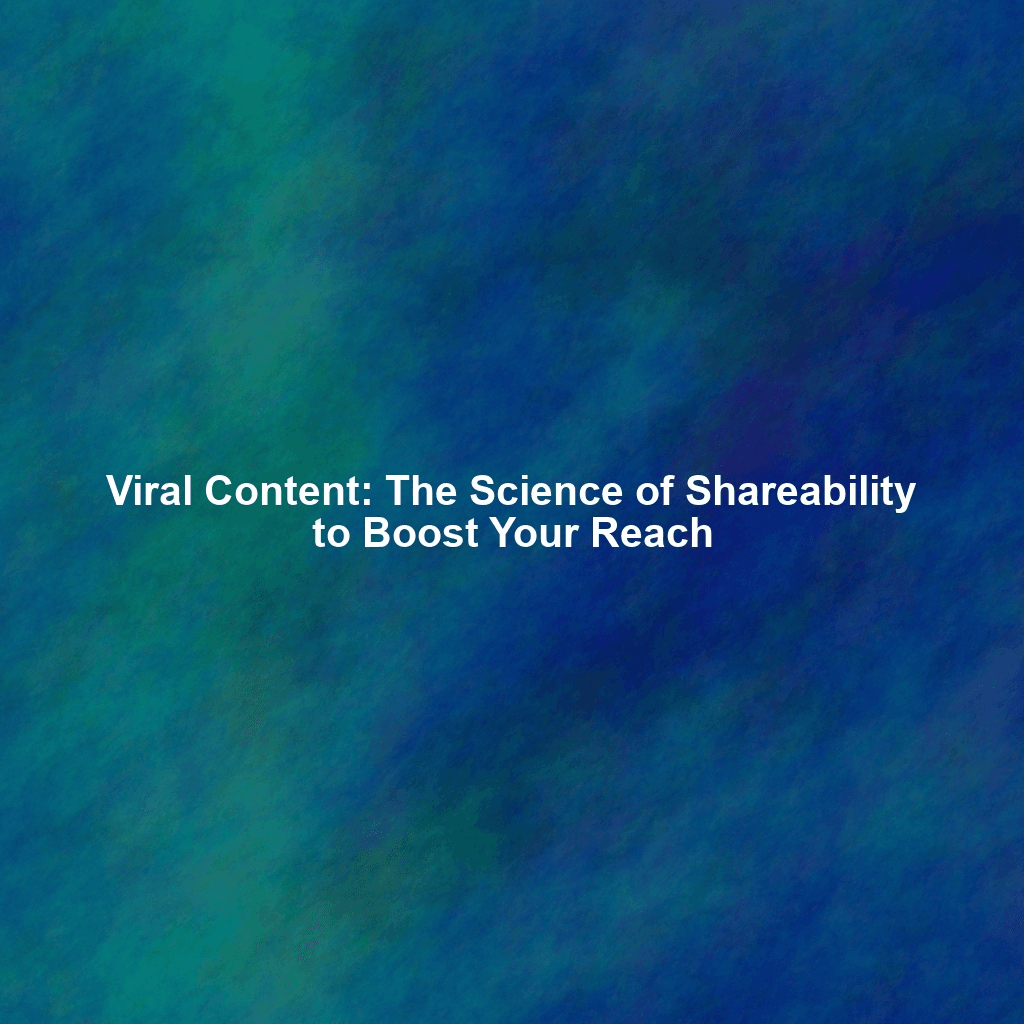Understanding the Shareability Factor: Why Content Goes Viral
In the bustling digital landscape, creating content is one thing; getting it shared is quite another. Why do some articles, videos, and infographics explode across the internet while others languish in obscurity? The answer lies in understanding the psychology behind sharing and strategically crafting content that resonates with your target audience’s intrinsic motivations.
Think about the last piece of content you shared. What compelled you to do so? Was it informative, entertaining, emotionally resonant, or perhaps a combination of all three? Identifying these ‘shareability factors’ is crucial to creating content that naturally attracts attention and encourages widespread dissemination.
The Psychology of Sharing: Tapping into Human Motivations
People share content for a variety of reasons, and understanding these motivations is key to crafting shareable content. Here are a few of the most prominent:
- Social Identity and Belonging: People share content that reflects their values, interests, and affiliations. Sharing a post about sustainable living, for example, can signal to their network that they care about the environment.
- Information and Utility: If content provides practical value, solves a problem, or offers unique insights, people are more likely to share it with others who might benefit.
- Entertainment and Amusement: Funny, heartwarming, or visually stunning content is inherently shareable because it provides a positive emotional experience.
- Status and Authority: Sharing content that positions them as knowledgeable or insightful can enhance their perceived status within their social circles.
- Relationship Building and Connection: Sharing content can be a way to start conversations, connect with others who share similar interests, and strengthen existing relationships.
- Support and Advocacy: People share content to support causes they believe in, raise awareness about important issues, or advocate for positive change.
Identifying Your Target Audience’s Sharing Motivations
While these are general motivators, understanding your specific audience’s sharing habits is crucial. What kind of content do they typically share? What are their values and interests? What problems are they trying to solve? Conducting audience research, analyzing social media data, and engaging directly with your audience can provide valuable insights into their sharing motivations.
Crafting Content That Demands to be Shared: Practical Strategies
Now that we’ve explored the psychology behind sharing, let’s delve into practical strategies for crafting content that is inherently shareable. These techniques focus on creating value, eliciting emotion, and optimizing your content for social sharing platforms.
Data-Driven Storytelling: Combining Facts and Emotion
People are drawn to stories, but compelling data adds credibility and weight to your message. Combining the two creates a powerful narrative that resonates with both logic and emotion. Use statistics, research findings, and case studies to support your claims, but present them in an engaging and relatable way.
For example, instead of simply stating “Climate change is a serious problem,” you could tell a story about a community affected by rising sea levels, using data to illustrate the extent of the damage and the urgency of the situation.
Visual Content: Capturing Attention in a Fast-Paced World
In the age of social media, visual content reigns supreme. Eye-catching images, compelling videos, and informative infographics are far more likely to capture attention and generate shares than text-heavy articles alone.
- Images: Use high-quality, visually appealing images that are relevant to your content. Consider using original photography, illustrations, or graphics to stand out from the crowd.
- Videos: Short, engaging videos are incredibly shareable. Create videos that tell a story, provide a tutorial, or offer a behind-the-scenes look at your brand.
- Infographics: Turn complex data into easily digestible visual representations. Infographics are perfect for summarizing key information, highlighting trends, and making data more accessible.
Headline Optimization: The First Step to Getting Noticed
Your headline is the first (and often only) impression you make on potential readers. A compelling headline can make the difference between a click and a scroll. Use power words, numbers, and questions to pique curiosity and entice readers to learn more.
Here are a few headline formulas to consider:
- The “How To” Headline: How to [Achieve Desired Result] in [Specific Timeframe]
- The Listicle Headline: [Number] Ways to [Solve a Problem]
- The Question Headline: Are You Making These [Common Mistake] Errors?
- The Controversial Headline: [Common Belief] is a Lie: Here’s Why
Creating Emotionally Resonant Content: Tapping into Feelings
Content that evokes strong emotions, whether positive or negative, is more likely to be shared. Consider incorporating elements of:
- Humor: Funny content is inherently shareable because it provides a positive emotional experience.
- Inspiration: Uplifting stories and motivational messages can inspire readers to share your content with others.
- Empathy: Content that acknowledges and validates readers’ emotions can create a strong connection and encourage sharing.
- Awe: Content that showcases beauty, wonder, or extraordinary achievements can inspire awe and amazement.
Offer Actionable Insights: Give Readers Tangible Value
Content that provides practical advice, actionable strategies, or valuable resources is more likely to be shared because it offers tangible value to the reader. Focus on providing solutions to common problems, offering helpful tips, and empowering readers to achieve their goals.
Optimizing for Social Sharing: Making it Easy to Spread the Word
Even the most compelling content won’t get shared if it’s not easy to do so. Optimizing your website and content for social sharing is crucial to maximizing your reach and amplifying your message.
Social Sharing Buttons: Making Sharing Effortless
Make it easy for readers to share your content by prominently displaying social sharing buttons on your website. Place them at the top, bottom, and side of your articles, ensuring they are visible and accessible on both desktop and mobile devices.
Consider using a social sharing plugin or tool that allows you to customize the appearance and functionality of your buttons. Some plugins also offer features such as share counts and social follow buttons.
Click-to-Tweet Quotes: Encouraging Bite-Sized Shares
Highlight key quotes or snippets from your content and make them easily shareable with click-to-tweet buttons. This allows readers to share specific points that resonate with them, increasing the likelihood of engagement and retweets.
Open Graph Meta Tags: Controlling How Your Content Appears on Social Media
Open Graph meta tags allow you to control how your content appears when it’s shared on social media platforms like Facebook and LinkedIn. These tags allow you to specify the title, description, image, and URL that will be displayed when your content is shared, ensuring that it looks its best and accurately represents your message.
By optimizing your Open Graph meta tags, you can significantly improve the click-through rate and engagement of your shared content.
Tailoring Content to Specific Platforms: Understanding Platform Nuances
Each social media platform has its own unique audience, culture, and best practices. Tailoring your content to suit the specific platform can significantly improve its performance and shareability.
- Facebook: Focus on visual content, engaging stories, and community building.
- Twitter: Use concise language, relevant hashtags, and compelling visuals.
- LinkedIn: Share professional insights, industry news, and thought-provoking articles.
- Instagram: Showcase visually stunning content, behind-the-scenes glimpses, and engaging stories.
- Pinterest: Create visually appealing graphics and link them to valuable resources.
Promoting Your Content: Getting the Ball Rolling
Creating great content is only half the battle. You also need to actively promote it to reach a wider audience and encourage sharing. Here are a few effective content promotion strategies:
Email Marketing: Reaching Your Existing Audience
Email marketing is a powerful tool for promoting your content to your existing audience. Send targeted emails to subscribers who are likely to be interested in your content, highlighting its key benefits and encouraging them to share it with their networks.
Social Media Promotion: Engaging Your Followers
Share your content on all your social media channels, using engaging captions and relevant hashtags. Encourage your followers to share your content by asking questions, running contests, and creating interactive polls.
Influencer Marketing: Leveraging Authority and Reach
Partner with influencers in your niche to promote your content to their followers. Influencers can help you reach a wider audience, build credibility, and drive more shares.
Paid Advertising: Amplifying Your Reach
Consider using paid advertising to reach a larger audience and promote your content to specific demographics. Social media platforms like Facebook, Twitter, and LinkedIn offer powerful targeting options that allow you to reach the right people with the right message.
Engage in Online Communities: Building Relationships and Sharing Value
Participate in relevant online communities, such as forums, groups, and Q&A sites. Share your content where appropriate, but focus on providing value and building relationships rather than simply self-promoting.
Analyzing and Iterating: Refining Your Strategy
The key to long-term success with content sharing is to continuously analyze your results and iterate on your strategy. Track your share counts, engagement metrics, and website traffic to identify what’s working and what’s not. Use this data to refine your content creation and promotion efforts, ensuring that you’re always delivering the most valuable and shareable content possible.
Track Key Metrics: Measuring Your Success
Pay attention to metrics like:
- Share Counts: How many times your content has been shared on each social media platform.
- Engagement Metrics: Likes, comments, and shares on your social media posts.
- Website Traffic: How much traffic your content is driving to your website.
- Referral Traffic: The percentage of your website traffic that comes from social media.
- Conversion Rates: The percentage of visitors who take a desired action, such as subscribing to your email list or making a purchase.
A/B Testing: Experimenting with Different Approaches
Conduct A/B tests to experiment with different headlines, images, and call-to-actions. This will help you identify which approaches are most effective at driving shares and engagement.
Staying Up-to-Date: Adapting to the Changing Landscape
The digital landscape is constantly evolving, so it’s important to stay up-to-date on the latest trends and best practices. Follow industry blogs, attend conferences, and experiment with new technologies to ensure that you’re always one step ahead of the competition.
Conclusion: The Path to Shareable Content Mastery
Getting more shares on your content is a continuous process of learning, experimentation, and refinement. By understanding the psychology behind sharing, crafting compelling content, optimizing for social sharing platforms, and actively promoting your work, you can significantly increase your reach, build a loyal audience, and achieve your content marketing goals. So, start implementing these strategies today and unlock the secrets to viral content success.
 Skip to content
Skip to content

